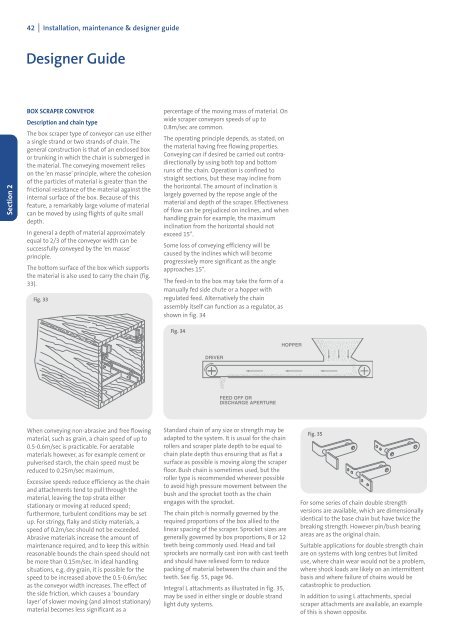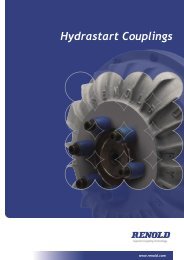Conveyor chain
Conveyor chain
Conveyor chain
Create successful ePaper yourself
Turn your PDF publications into a flip-book with our unique Google optimized e-Paper software.
Section 2<br />
42 I Installation, maintenance & designer guide<br />
Designer Guide<br />
BOX SCRAPER CONVEYOR<br />
Description and <strong>chain</strong> type<br />
The box scraper type of conveyor can use either<br />
a single strand or two strands of <strong>chain</strong>. The<br />
general construction is that of an enclosed box<br />
or trunking in which the <strong>chain</strong> is submerged in<br />
the material. The conveying movement relies<br />
on the ‘en masse’ principle, where the cohesion<br />
of the particles of material is greater than the<br />
frictional resistance of the material against the<br />
internal surface of the box. Because of this<br />
feature, a remarkably large volume of material<br />
can be moved by using flights of quite small<br />
depth.<br />
In general a depth of material approximately<br />
equal to 2/3 of the conveyor width can be<br />
successfully conveyed by the ‘en masse’<br />
principle.<br />
The bottom surface of the box which supports<br />
the material is also used to carry the <strong>chain</strong> (fig.<br />
33).<br />
Fig. 33<br />
When conveying non-abrasive and free flowing<br />
material, such as grain, a <strong>chain</strong> speed of up to<br />
0.5-0.6m/sec is practicable. For aeratable<br />
materials however, as for example cement or<br />
pulverised starch, the <strong>chain</strong> speed must be<br />
reduced to 0.25m/sec maximum.<br />
Excessive speeds reduce efficiency as the <strong>chain</strong><br />
and attachments tend to pull through the<br />
material, leaving the top strata either<br />
stationary or moving at reduced speed;<br />
furthermore, turbulent conditions may be set<br />
up. For stringy, flaky and sticky materials, a<br />
speed of 0.2m/sec should not be exceeded.<br />
Abrasive materials increase the amount of<br />
maintenance required, and to keep this within<br />
reasonable bounds the <strong>chain</strong> speed should not<br />
be more than 0.15m/sec. In ideal handling<br />
situations, e.g. dry grain, it is possible for the<br />
speed to be increased above the 0.5-0.6m/sec<br />
as the conveyor width increases. The effect of<br />
the side friction, which causes a ‘boundary<br />
layer’ of slower moving (and almost stationary)<br />
material becomes less significant as a<br />
percentage of the moving mass of material. On<br />
wide scraper conveyors speeds of up to<br />
0.8m/sec are common.<br />
The operating principle depends, as stated, on<br />
the material having free flowing properties.<br />
Conveying can if desired be carried out contradirectionally<br />
by using both top and bottom<br />
runs of the <strong>chain</strong>. Operation is confined to<br />
straight sections, but these may incline from<br />
the horizontal. The amount of inclination is<br />
largely governed by the repose angle of the<br />
material and depth of the scraper. Effectiveness<br />
of flow can be prejudiced on inclines, and when<br />
handling grain for example, the maximum<br />
inclination from the horizontal should not<br />
exceed 15°.<br />
Some loss of conveying efficiency will be<br />
caused by the inclines which will become<br />
progressively more significant as the angle<br />
approaches 15°.<br />
The feed-in to the box may take the form of a<br />
manually fed side chute or a hopper with<br />
regulated feed. Alternatively the <strong>chain</strong><br />
assembly itself can function as a regulator, as<br />
shown in fig. 34<br />
Fig. 34<br />
DRIVER<br />
FEED OFF OR<br />
DISCHARGE APERTURE<br />
Standard <strong>chain</strong> of any size or strength may be<br />
adapted to the system. It is usual for the <strong>chain</strong><br />
rollers and scraper plate depth to be equal to<br />
<strong>chain</strong> plate depth thus ensuring that as flat a<br />
surface as possible is moving along the scraper<br />
floor. Bush <strong>chain</strong> is sometimes used, but the<br />
roller type is recommended wherever possible<br />
to avoid high pressure movement between the<br />
bush and the sprocket tooth as the <strong>chain</strong><br />
engages with the sprocket.<br />
The <strong>chain</strong> pitch is normally governed by the<br />
required proportions of the box allied to the<br />
linear spacing of the scraper. Sprocket sizes are<br />
generally governed by box proportions, 8 or 12<br />
teeth being commonly used. Head and tail<br />
sprockets are normally cast iron with cast teeth<br />
and should have relieved form to reduce<br />
packing of material between the <strong>chain</strong> and the<br />
teeth. See fig. 55, page 96.<br />
Integral L attachments as illustrated in fig. 35,<br />
may be used in either single or double strand<br />
light duty systems.<br />
HOPPER<br />
Fig. 35<br />
For some series of <strong>chain</strong> double strength<br />
versions are available, which are dimensionally<br />
identical to the base <strong>chain</strong> but have twice the<br />
breaking strength. However pin/bush bearing<br />
areas are as the original <strong>chain</strong>.<br />
Suitable applications for double strength <strong>chain</strong><br />
are on systems with long centres but limited<br />
use, where <strong>chain</strong> wear would not be a problem,<br />
where shock loads are likely on an intermittent<br />
basis and where failure of <strong>chain</strong>s would be<br />
catastrophic to production.<br />
In addition to using L attachments, special<br />
scraper attachments are available, an example<br />
of this is shown opposite.




